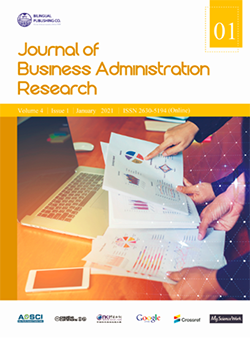The Relationship Between the Circular Economy and Sustainable Waste Management in European Union
DOI:
https://doi.org/10.30564/jbar.v4i1.2709Abstract
Modern life has contributed both to increasing living standards, increasing comfort and the development of society, but also to increasing the amount of waste that suffocates the planet and threatens the existence of present and future generations. Among the solutions that are sought and that are included in various programs and policies, the concept of circular economy is one that is increasingly discussed when talking about the sustainable development of society. The circular economy implies a reduction of the natural resources consumed due to both recycling and their fair consumption. At the U.E. level the foundations have been laid for policies aimed at waste management to ensure the application of the principles of the circular economy.
Considering the importance that the quantification of the indicators for implementing the circular economy have on the elaboration of more efficient policies, but also on the determination of the degree of implementation of this concept, in this paper we intend to analyze the evolution of these indicators from 2010-2019, in the European Union using a customized version of the DPSIR model. Their analysis led us to the conclusion that although important steps have been taken towards the transition to the circular economy, there are still many aspects that need to be improved in order to achieve the proposed objectives through European policies.
Keywords:
Circular economy; Waste; Sustainability; European policiesReferences
[1] Bradley Patricia. Using the DPSIR Framework to Develop a Conceptual Model: Technical Support Document, Report number: EPA/600/R-15/154, U.S. Environmental Protection Agency, Office of Research and Development, 2015, DOI:10.13140/RG.2.1.1870.7608, accessed in 6.01.2021
[2] Carr R. Edward, Wingard M. Philip, Yorty C. Sara, Thompson- Hall Sara. Applying DPSIR to sustainable development. The International Journal of Sustainable Development and World Ecology, 2007, 14(6). DOI: 10.1080/13504500709469753, https://www.researchgate.net/publica - tion/228618840_Applying_DPSIR_to_sustainable_ development
[3] Chang An-Pi. A Talk on the Essence of Circular Cities. Journal of Business Administration Research, 2020, https://ojs.bilpublishing.com/index.php/jbar/article/ view /2218/pdf
[4] Kristensen Peter. The DPSIR Framework, Institut français de recherche pour l’exploitation de la mer , 2004 https://wwz.ifremer.fr/dce/content/download /69291/913220/.../DPSIR.pdf
[5] Marcuta Alina, Simionescu Anca, Tindeche Cristina, Marcuta Liviu. Relationship between sustainable development and public health. Case study Romania, Scientific Papers Series Management, Economic Engineering in Agriculture and Rural Development, 2018, 18(3): 251-259. PRINT ISSN: 284-7995, E-ISSN: 2285-3952
[6] Olaru, B.G., Zecheru, V. The waste recycling in Romania, Scientific Papers Series Management, Economic Engineering in Agriculture and Rural Development, 2016, 16(3).
[7] Stahel, W., Reday-Mulvey, G. The Potential for Substituting Manpower for Energy, Final Report 30 July 1977 for the Commission of the European Communities, Research contract no 76/l3-V/343/78- EN, 1977.
[8] Tartiu Valentina Elena, Stefanescu Mihaela, Petrache Ana Maria, Gurau Catalin Razvan. Tranzitia catre o economie circulara. De la managementul deseurilor la o economie verde in Romania, Institutul European din Romania, 2019. ISBN online: 978-606-8202-62-4
[9] Ellen MacArthur Funation, What is the Circular economy?, https://www.ellenmacarthurfoundation.org/circular-economy/what-is-the-circular-economy, accessed in 1.12.2020
[10] Statistical Office of European Union (EUROSTAT). Waste statistics, , 2020. www.ec.europa.eu, accessed 2.12.2020
[11] European Environment Agency. Air Pollution in Europe 1997, Cataloguing data can be found at the end of this publication, EEA, Copenhagen, 1997. ISBN: 92-9167-059-6, Last modified 23 Nov 2020, https://www.eea.europa.eu/publications/92-9167- 059-6-sum, accessed in 3.12.2020
[12] European Environment Agency. Waste: a problem or a resource? , 2014 https://www.eea.europa.eu/signals/signals-2014/ articles/waste-a-problem-or-a-resource, accessed in 3.12.2020
[13] OECD. Global Material Resources Outlook to 2060 - Economic drivers and environmental consequences, OECD Publishing, Paris, 2018. oe.cd/materials-outlook accessed in 14.12.2020
Downloads
Issue
Article Type
License
Copyright and Licensing
The authors shall retain the copyright of their work but allow the Publisher to publish, copy, distribute, and convey the work.
Journal of Business Administration Research publishes accepted manuscripts under Creative Commons Attribution-NonCommercial 4.0 International License (CC BY-NC 4.0). Authors who submit their papers for publication by Journal of Business Administration Research agree to have the CC BY-NC 4.0 license applied to their work, and that anyone is allowed to reuse the article or part of it free of charge for non-commercial use. As long as you follow the license terms and original source is properly cited, anyone may copy, redistribute the material in any medium or format, remix, transform, and build upon the material.
License Policy for Reuse of Third-Party Materials
If a manuscript submitted to the journal contains the materials which are held in copyright by a third-party, authors are responsible for obtaining permissions from the copyright holder to reuse or republish any previously published figures, illustrations, charts, tables, photographs, and text excerpts, etc. When submitting a manuscript, official written proof of permission must be provided and clearly stated in the cover letter.
The editorial office of the journal has the right to reject/retract articles that reuse third-party materials without permission.
Journal Policies on Data Sharing
We encourage authors to share articles published in our journal to other data platforms, but only if it is noted that it has been published in this journal.




 Marcuta Liviu
Marcuta Liviu

